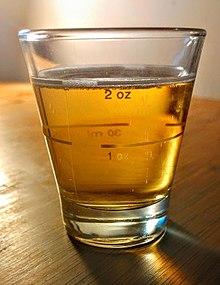Fluid ounce
| Fluid ounce | |
|---|---|
 An example of a 2 fluid ounce (fl oz) shot glass in British Imperial units | |
| General information | |
| Unit system | Imperial units, US customary units |
| Unit of | Volume |
| Symbol | fl oz |
| Conversions (imperial) | |
| 1 imp fl oz in ... | ... is equal to ... |
| SI units | 28.41306 mL |
| US customary units | 0.9607599 US fl oz |
| Conversions (US) | |
| 1 US fl oz in ... | ... is equal to ... |
| SI units | 29.57353 mL |
| Imperial units | 1.040843 imp fl oz |
A fluid ounce (abbreviated fl oz, fl. oz. or oz. fl., old forms ℥, fl ℥, f℥, ƒ ℥) is a unit of volume (also called capacity) typically used for measuring liquids. The British Imperial, the United States customary, and the United States food labeling fluid ounce are the only three that are still in common use, although various definitions have been used throughout history.
An imperial fluid ounce is 1⁄20 of an imperial pint, 1⁄160 of an imperial gallon or exactly 28.4130625 mL.
A US customary fluid ounce is 1⁄16 of a US liquid pint and 1⁄128 of a US liquid gallon or exactly 29.5735295625 mL, making it about 4.08% larger than the imperial fluid ounce.
A US food labeling fluid ounce is exactly 30 mL.
Comparison to the ounce
The fluid ounce is distinct from the (international avoirdupois) ounce as a unit of weight or mass, although it is sometimes referred to simply as an "ounce" where context makes the meaning clear (e.g., "ounces in a bottle"). A volume of pure water measuring one imperial fluid ounce has a mass of almost exactly one ounce.
Definitions and equivalences
- Imperial fluid ounce
1 imperial fluid ounce = 1⁄160 imperial gallon = 1⁄40 imperial quart = 1⁄20 imperial pint = 1⁄10 imperial cup = 1⁄5 imperial gill = 8 imperial fluid drams = 28.4131 millilitres[1] ≈ 1.733871 cubic inches ≈ 0.960760 US fluid ounces ≈ the volume of 1 avoirdupois ounce of water[2]
- US customary fluid ounce
1 US fluid ounce = 1⁄128 US gallon = 1⁄32 US quart = 1⁄16 US pint = 1⁄8 US cup = 1⁄4 US gill = 2 US tablespoons = 6 US teaspoons = 8 US fluid drams = 1.804688 cubic inches[3] = 29.5735 millilitres ≈ 1.040843 imperial fluid ounces
- US food labeling fluid ounce
For serving sizes on nutrition labels in the US, regulation 21 CFR §101.9(b) requires the use of "common household measures", and 21 CFR §101.9(b)(5)(viii) defines a "common household" fluid ounce as exactly 30 milliliters.[4]
History
The fluid ounce was originally the volume occupied by one ounce of some substance, for example wine (in England) or water (in Scotland). The ounce in question also varied depending on the system of fluid measure, such as that used for wine versus ale.
Various ounces were used over the centuries, including the Tower ounce, troy ounce, avoirdupois ounce, and ounces used in international trade, such as Paris troy, a situation further complicated by the medieval practice of "allowances", whereby a unit of measure was not necessarily equal to the sum of its parts. For example, the 364-pound woolsack (165 kg) had a 14-pound allowance (6.4 kg) for the weight of the sack and other packaging materials.[5]
In 1824, the British Parliament defined the imperial gallon as the volume of ten pounds of water at standard temperature.[2] The gallon was divided into four quarts, the quart into two pints, the pint into four gills, and the gill into five ounces; thus, there were 160 imperial fluid ounces to the gallon.
This made the mass of a fluid ounce of water one avoirdupois ounce (28.35 g), a relationship which remains approximately valid today despite the imperial gallon's definition being slightly revised to be 4.54609 litres (thus making the imperial fluid ounce exactly 28.4130625 mL).
The US fluid ounce is based on the US gallon, which in turn is based on the wine gallon of 231 cubic inches that was used in the United Kingdom prior to 1824. With the adoption of the international inch, the US fluid ounce became 1⁄128 gal × 231 in3/gal × (2.54 cm/in)3 = 29.5735295625 mL exactly, or about 4% larger than the imperial unit.
References and notes
- ^ a b "The Units of Measurement Regulations 1995 (Schedule)". 20 September 2000. Retrieved 18 April 2006.
- ^ a b The imperial gallon was originally defined as the volume occupied by ten avoirdupois pounds (4.54 kg) of distilled water weighed in air with brass weights with the barometer standing at 30 inches of mercury (102 kPa) at a temperature of 62 °F (16.7 °C).
- ^ a b One US gallon is defined as 231 cubic inches.
- ^ "21 CFR §101.9". Retrieved 2019-05-31.
- ^ Connor, R. D.; Simpson, Allen David Cumming; Morrison-Low, A. D.; National Museums of Scotland (2004). Weights and measures in Scotland: a European perspective. NMS. p. 153. ISBN 978-1-901663-88-4. Retrieved 21 September 2012.
